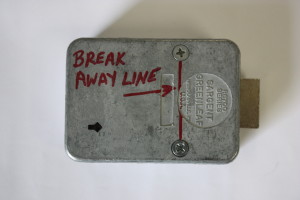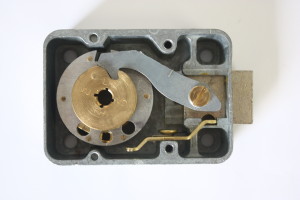Most safe manufacturers tell you that they have relock devices in their safes, but they never tell you what one is or what it does.
The most common form of relocker is the “internal” relocker. “Internal” because it is located inside the lock body on safe locks that are rated Group 2 or higher. Burglars attempting to break into a safe will frequently smash the lock dial on the outside of the safe with a hammer, bat or anything else they can swing. The force of that blow will drive the dial spindle back into the safe, against the back cover of the lock body. The lock body is located inside the safe door. Enough force will cause the back cover to break away along a line that is intentionally made weak by the lock manufacturer. When this occurs a spring loaded “relock trigger” pops into a hole in the lock bolt. The lock bolt is the part that actually keeps your safe locked, by preventing the big bolts in the door edge from being pushed back in. With the relock trigger in that hole, then the lock bolt is deadlocked and cannot be forced to unlock.
Picture on left shows back cover of S&G Group 2 lock. Picture on right shows lock with cover removed. Relocker is the angled brass piece in lower right. Since the lock cover is removed the relocker is “fired”, and you can see the right end of it is in the hole on the lock bolt.
If the relocker is set off this way a burglar is much less likely to get into your safe. You will not be able to open it either. An experienced safe technician will be able to open you safe and make it useable again. Note that most locksmiths are not skilled at opening locked safes, especially when a relocker has been set off.
Next posting will be on external relockers.



